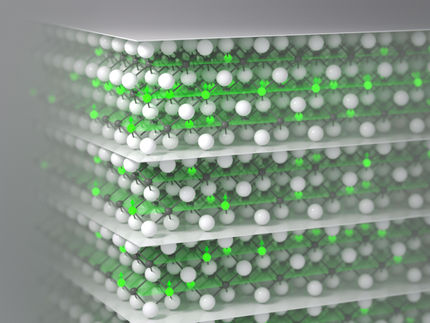Quasiparticle solves mystery of vanishing conductivity
CAU team detects polarons in rare earth compound for the first time
Advertisement
Electrons determine the properties of all materials: they decide whether a metal conducts electricity, how a semiconductor functions or which magnetic effects occur. In some materials, the electrons behave in a particularly unusual way: they switch between different states, strongly influence each other and can even cause a metal to suddenly become an insulator - a substance that no longer conducts electricity.
An international team led by Dr. Chul-Hee Min and Professor Kai Rossnagel at Kiel University (CAU) has now deciphered a crucial mechanism. In a compound of thulium, selenium and tellurium (TmSe₁₋ₓTeₓ), the researchers investigated a material based on a rare earth metal (thulium). These metals exhibit special electronic properties that are used in many key technologies.
The team discovered a previously unknown quasiparticle in the material. It is created by the interaction of electrons and atoms and explains why the material changes its electrical properties. The researchers published their findings in the journal Physical Review Letters.
When metals suddenly become insulators
If the proportion of tellurium in the compound TmSe₁₋ₓTeₓ increases to around 30 percent, the material stops conducting electricity and transforms from a semi-metal into an insulator. These transitions fascinate physicists because they show that the properties of a material cannot be explained by its chemical composition alone. Electrons strongly influence each other, couple to the vibrations of the crystal lattice - the regular network of atoms in the solid - and together form particle-like states with new properties, so-called quasiparticles.
The researchers examined the material at an atomic level in order to understand these processes. They carried out the measurements using high-resolution photoemission spectroscopy at various synchrotron radiation sources around the world, including the Ruprecht Haensel Laboratory, a joint facility of Kiel University and the German Electron Synchrotron DESY. They irradiated the sample with intense X-rays and measured the exit angles and energies of the electrons. The spectra show how strongly electrons are bound in certain states and provide information about the underlying interaction processes.
Discovery of polarons
The spectroscopic measurements revealed new details about the movement of electrons in the material: a small additional signal kept appearing, which looked like a small bump next to the main signal. At first, the researchers thought it was a technical blur, but the signal also appeared in repeated measurements. This recurring phenomenon prompted the Kiel team to systematically investigate the history and behavior of the material over a period of years - a search for clues that ultimately led to the discovery of the quasiparticles.
First author Dr. Chul-Hee Min began researching TmSe₁₋ₓTeₓ back in 2015. Initially he was looking for topological surface states, later his focus was on the electronic behavior inside the material. For a long time, the additional signal next to the main peak remained an unsolved mystery.
It was only after years of analysis and close collaboration with international theorists that the team identified the cause: the signal originated from polarons, quasiparticles in which an electron is closely coupled to the vibrations of the crystal lattice. The electron moves together with the distortion of the atoms and thus forms a new, composite particle. In their research, the scientists used the periodic Anderson model, a theoretical model that describes how electrons interact with each other in such metals. By extending the model to include the coupling of the electrons to the vibrations of the crystal lattice, they were able to precisely explain the spectroscopic measurements. "That was the decisive step," explains Min. "As soon as we included this interaction in the calculations, the simulation and measurements fitted together perfectly."
Polarons - the dance of electrons and atoms
A polaron can be vividly described as a kind of "dance" between an electron and the atoms surrounding it. In ordinary metals, electrons flow almost freely. In this material, however, they move together with slightly distorted atomic layers, comparable to a dent moving through the crystal lattice. This coupling slows down the electrons, changes the electrical conductivity and explains the transition to an insulator.
"In quantum materials such as TmSe₁₋ₓTeₓ, whose exotic properties stem from the quantum mechanical properties of their electrons, this effect has not yet been experimentally demonstrated," says Professor Kai Rossnagel, Director at the Institute of Experimental and Applied Physics (IEAP) at Kiel University and spokesperson for the research focus KiNSIS - Kiel Nano, Surface and Interface Science. "The fact that we were able to make it visible here for the first time shows what interesting new phenomena can still be discovered in the quantum cosms of materials."
Potential for microelectronics and quantum technology The findings have an impact beyond the material under investigation. Similar coupling effects occur in many modern quantum materials - from high-temperature superconductors to 2D materials. In the future, researchers could use polarons in a targeted manner to control electronic, optical or magnetic material properties or to create entirely new states of matter.
"Such discoveries often arise from persistent basic research," says Rossnagel. "But they are exactly what can lead to new technologies in the long term."
Note: This article has been translated using a computer system without human intervention. LUMITOS offers these automatic translations to present a wider range of current news. Since this article has been translated with automatic translation, it is possible that it contains errors in vocabulary, syntax or grammar. The original article in German can be found here.
Other news from the department science
Most read news
More news from our other portals
See the theme worlds for related content
Topic World Spectroscopy
Investigation with spectroscopy gives us unique insights into the composition and structure of materials. From UV-Vis spectroscopy to infrared and Raman spectroscopy to fluorescence and atomic absorption spectroscopy, spectroscopy offers us a wide range of analytical techniques to precisely characterize substances. Immerse yourself in the fascinating world of spectroscopy!

Topic World Spectroscopy
Investigation with spectroscopy gives us unique insights into the composition and structure of materials. From UV-Vis spectroscopy to infrared and Raman spectroscopy to fluorescence and atomic absorption spectroscopy, spectroscopy offers us a wide range of analytical techniques to precisely characterize substances. Immerse yourself in the fascinating world of spectroscopy!
























































